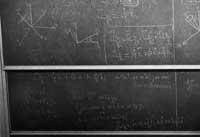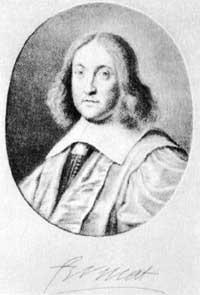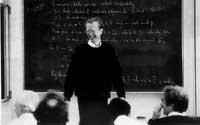On the last theorem of Fermat
The mathematicians who were listening soon realized that Wiles paralyzed the complicated problem of Mathematics, known as the "Fermat theorem." Soon the news spread to all the mathematicians of the world. Also those who were not mathematicians, as witnesses of newspaper, radio and television quotes. Wiles' manuscript, however, was in the hands of a few, as the author did not want to publish it until all the technical aspects contained in the demonstration were verified.

And it seems that a part had gaps (not mistakes) and until the last theorem of Ferma covered them it would have to remain an open problem. With this doubt I closed the first version of the article, but according to a news that has been expanded a few days ago, they have made the calculation that was missing and although we have to wait for the approval of the experts, it seems that this time we can put the name of theorem in its true sense to the result that Fermat proposed to us.
Fermat
The man who named the problem, Pierre de Fermat, was born in 1601 in Beaumont de Lomagne, a Gascon village located in the current department of Tarn and Garonne. He was a well-to-do son (his father was a merchant) and studied law at the universities of Toulouse, Bordeaux and Orleans. From 1631 he worked as a lawyer in the Parliament of Toulouse.
And it is that, together with Newton and Leibniz, the XVII. Fermat was at the top of twentieth-century mathematics, never devoted himself entirely to mathematics, but out of work. But the structure of the universities of that time was very different from the current one, and the advancement of the sciences often came from non-professional scientists. He died in Castres in 1655.
During his stay in Bordeaux, Fermat apparently used to study the work of mathematician François Viète and the simplicity of his symbolic writing. We also say that Viète was better known in his time as a politician and was personal advisor to Henry IV (Henry III of Navarre). Fermat's contributions can be seen in all areas of mathematics: He gave the beginnings of Analytical Geometry at the same time as Descartes, proposed methods of calculating maximums and minimums and of realizing quadratures in Analysis, although soon the Infinitesimal Calculations of Newton and Leibniz darkened and emerged as an independent field with the same Theory of Numbers, as it is said.
In optics, the law of refraction of light is also called Fermat principle and in the beginning of Probability appears next to Pascal. However, he still did not enjoy great popularity, as he did not publish books. His works have come to us in letters, small works and manuscripts. The mere mention of all contributions would take us a long time and here we join the evolution of Fermat's last theorem.
We have to go to Greek in search of the first traces, which for the first time dealt with numbers and geometric figures. d. C. III. In the 19th century, the mathematician based in Alexandria Diofanto wrote some books in which knowledge of Greek arithmetic was collected. These books were translated into Arabic and their influence on Arab mathematics was evident. In the Middle Ages, when they reached western Europe only six of the early fourteen remained. Four of the seven recently lost books have been found in the Messed of Iran, in 1971, in the Arabic translation.

These six ancient figures were published by Bachet de Mériziac in 1621, adding Latin translation and commentary to the Greek. This was the main source of Number Theory results for Ferma. In fact, in the same book Fermat wrote his notes and comments and after his death his son was in charge of publishing them with the notes of Father Arithmetica of Diofanto.
The first traces of the problem we are dealing with are found in the Pythagorean triples, that is, in the calculation of integers that meet the equation x 2 + and 2 = z 2. For example (3, 4, 5) or (5, 12, 13). With a little work you can also get a formula that gives all. Fermat proposed using any other exponent instead of generalized and square questions. And at one end of the book mentioned Arithmetica wrote: “It is impossible to divide a cube into two cubes, and one slotted in two pairs or, in general, any other remodeling that is not square, in two vegetables of the same exponent. I have found a wonderful demonstration of it, but this page edge is too small to enter it.” That is,
x n + and n = z n
Fermat argued that the equation does not have a very positive solution when n is greater than two. In other results that left us without evidence only remained unrecognizable a few years later, and that is why it is called the last theorem of Fermat, although the unproven result does not deserve the name of theorem.
Today no one believes that this result of Fermat was a demonstration. In the letters he only mentioned case n = 3 and solved the method he used case n = 4 for another problem. It is possible that from these two it is considered that generalization was possible or that some other error is made, but it is not possible to determine it.
Kummer
It is enough to take into account n = 4 and n the first odd, since all the others can be summarized in them. XIX. At the beginning of the century only cases n = 3 and 4 were known. Legendre obtained a response n = 5 in 1825 and Dirichlet, after another demonstration in this case, studied the case n = 7. Indemostrable, resolved n = 14 in 1832 and seven years later Lamé came to answer n = 7. Meanwhile, the French Academy offered an award in exchange for a complete demonstration.
The real breakthrough came between 1844 and 47 with the work of Ernst Kummer. This studied very cycllotomic numbers:
to 0 + to 1w + to n-1
of
, to 1, ... to n-1 integers
and
w = e 2</n (therefore n = 1)
are.
These numbers, like conventional integers, can be factored into prime numbers, but unlike conventional ones, in some cases there may be more than one factorization for the same number. At first he did not realize this problem and made some mistakes, but then he created the theory of the ideal numbers to solve it, on the one hand, and the class body, on the other. To measure how “bad” factoring can be, he introduced the concept of class number.
In this regard he defined the first regular numbers and demonstrated that for them the last theorem of Fermat is true. He showed a criterion for knowing these numbers and the prime numbers below 100 only 37, 59 and 67 are irregular. Kummer's innovation was a spectacular breakthrough. Although in 1850 the French Academy offered for the second time the prize, years later it retired and decided to deliver the gold medal of the Grand Prix to Kummer, as proposed by Cauchy. Then Kummer developed methods to analyze cases that were missing below the tissues but XX. At the beginning of the century Vandiver filled the holes he left.

XIX. In the 18th century, no progress was made but partial results were obtained. XX. In the early 20th century, in 1905, Paul Wolfskehl of the Götingen Society of Sciences offered 100,000 frames for the first demonstration. The sound of money, in addition to professional mathematicians, brought fans to the square and came hundreds of resolutions. But all in vain. The value of the prize was greatly reduced by the devaluations of the framework, but some believe that without money they have tried with totally elementary means.
XX. century
XX. As the computing capacity of computers has increased in the 20th century, it has been possible to perform checks for the special values of n. This cannot prove in any case the whole theorem, but if it is known to be true below n = 4,000,000 (hence they arrived in 1993) it can hardly leave trace to believe otherwise. However, in Mathematics tests are needed.
The development of algebraic geometry was responsible for the XX. Change of strategy in the 20th century with respect to Fermat's last theorem. Some problems that have appeared in curves and surfaces studies may be related to Fermat's theorem. Some of the aieros proposed in the three fields (diophantine geometry, arithmetic surfaces and elliptical curves) immediately deduced that of Fermat.
In 1983 the German Gerd Faltings demonstrated a conjecture proposed by Mordell sixty years earlier and, consequently, that the equations x n + and n = z n are a finite number of “really” different solutions for each n, when n' 3. What really means different. If the trio (3, 4, 5) meets the equation x 2 + and 2 = z 2, it is evident (6, 8, 10), (9, 12, 15) and, in general, any multiple complies.
All of them can be considered as the same resolution. But the trios (5, 12, 13) and (7, 24, 25) are also resolutions and are not equal. And it is easy to observe that in n = 2 the different solutions are infinite. According to the Faltings theorem this does not occur when n Ž 3. The goal is to prove that there is none, but it was a step forward. In addition to Mordell, Faltings solved two other great conjectures that earned him the Fields medal in 1986.
On the other hand, about six years ago Miyaoka claimed a differentiation related to arithmetic surfaces (Bogomolov-Miyaoka-Yau). If it had been true, at least for the majors of a fixed value of n we would have come to the conclusion that the last theorem of Ferma is fulfilled, but they found an error to the demonstration and we remained in the same state.
Wiles' work is situated in the field of elliptical curves. In 1955 the Japanese mathematician Yukata Taniyama proposed a conjecture that was determined in the next decade by Goro Shimura. In algebraic terminology he says: “Any elliptical, modular curve on rational numbers.” For many years no one thought that this conjecture could have to do with Fermat's theorem, until the German Gerhard Frey in 1985 claimed that the aieru Taniyama-Shimura is harder than Fermat's theorem, that is, that the demonstration of the first brings with it the second. He was not able to concretize, but in the coming years it became clear that Frey was fine with the work that Jean Pierre Serre directed and ended with Kenneth Ribet.

The aim of Andrew Wiles's work in recent years has been the conjecture of Taniyama-Shimura. Despite not demonstrating the most general case, he supposedly managed to prove it for many curves and what left decided the Fermat theorem in them. According to experts, the demonstration had a lot of credibility and that is why the news spread all over the world. As usual, before publication, the work was left in the hands of experts for approval. Months later, we began to hear that something was wrong.
Trying to clarify things, Wiles himself published in December 1993 a note in which he recognized that in his manuscript they found some points that had to be completed in the review and that he had solved most of them, but that one had escaped, which required that we could not conclude his work until he mastered the calculation. By the way, in the spring he gave details of what he had done and what was missing for the course he was going to teach.
Spring and summer were, and since there was no more news, I ended the first draft of this article with that and perhaps soon you could get to the show. But when I was doing the last writing and corrections, the news came that we expected.
It opened on 25 October 1994, although with less intensity than the previous one. As the need to review after that initial euphoria remained in universities, it will probably also be limited to professional environments. They say that the problem to be solved has been addressed by another way and they have succeeded. Wiles took prudence last day and left the manuscript in the hands of a few.
This time I would also, of course, but since October 25 has done the manuscript, we can safely consider it as a sign. And with him comes his second work with Richard Taylor, which seems to indicate how you can do the missing calculation in the initial. Experience shows us that until the last blessings arrive we cannot say that we have a definitive demonstration. But, at the same time, we have many reasons to believe that the problem that became the famous headaches of mathematicians for 350 years is solved. And as has been said in the jokes, Fermín was right when he wrote that it did not fit on the edge of the page.





